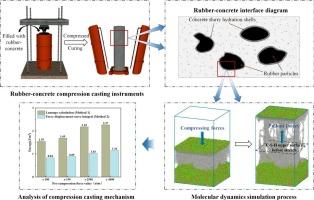当前位置:
X-MOL 学术
›
Cem. Concr. Res.
›
论文详情
Our official English website, www.x-mol.net, welcomes your
feedback! (Note: you will need to create a separate account there.)
Understanding nanoscale mechanism of compression casting on rubber-cement interface: A molecular dynamics study
Cement and Concrete Research ( IF 10.9 ) Pub Date : 2024-10-18 , DOI: 10.1016/j.cemconres.2024.107700 Juntao Kang, Kai Wang, Yugui Cao, Lei Wang, Xingxiang Chen, Tianyue Wu, Zechuan Yu
Cement and Concrete Research ( IF 10.9 ) Pub Date : 2024-10-18 , DOI: 10.1016/j.cemconres.2024.107700 Juntao Kang, Kai Wang, Yugui Cao, Lei Wang, Xingxiang Chen, Tianyue Wu, Zechuan Yu

|
Using rubber particles as concrete aggregate can effectively address the issue of “black pollution” caused by waste tires. Although the inclusion of rubber particles reduces concrete strength, a compression casting method can enhance its mechanical properties, offering a novel approach to expanding the application range of rubber-concrete. Further development of the compression casting method requires an in-depth understanding of the mechanism behind the novel technique. This study focuses on the nanoscale mechanism of the compression casting, via all-atom molecular dynamics simulations of a C-S-H/rubber interface. Surface roughness is introduced to the employed C-S-H model, providing a more realistic representation of the cement surface compared to existing studies. Models subjected to various levels of compression casting are prepared and tested. Interface integrity is found to be significantly improved with sufficient pre-compression. When the pre-compression force increases from 100 atm to 4000 atm, the peak pullout force of the C-S-H/rubber interface transition zone increases by 90.26%, and the interfacial bond energy increase by 56.65% to 2.27 J/m2 . Lastly, a novel pre-compression method for rubber-concrete aggregate is proposed to enhance its economic and engineering applicability. This study reports an in-depth investigation on compression casting mechanisms and contributes to advancement of compression casting methods.
中文翻译:

了解橡胶-水泥界面上压缩铸造的纳米级机制:分子动力学研究
使用橡胶颗粒作为混凝土骨料,可以有效解决废旧轮胎造成的“黑污染”问题。尽管橡胶颗粒的加入会降低混凝土的强度,但压缩铸造方法可以增强其机械性能,为扩大橡胶混凝土的应用范围提供了一种新的方法。压缩铸造方法的进一步发展需要深入了解新技术背后的机制。本研究的重点是通过 C-S-H/橡胶界面的全原子分子动力学模拟来研究压缩铸造的纳米级机制。将表面粗糙度引入所采用的 C-S-H 模型,与现有研究相比,提供了更真实的水泥表面表示。准备和测试经受不同级别压缩铸造的模型。发现足够的预压缩可以显着提高界面完整性。当预压缩力从 100 atm 增加到 4000 atm 时,C-S-H/橡胶界面过渡区的峰值拉拔力增加了 90.26%,界面结合能增加了 56.65% 至 2.27 J/m2。最后,提出了一种新型的橡混骨料预压制方法,以增强其经济性和工程适用性。本研究报告了对压铸机理的深入研究,并为压铸方法的进步做出了贡献。
更新日期:2024-10-18
中文翻译:

了解橡胶-水泥界面上压缩铸造的纳米级机制:分子动力学研究
使用橡胶颗粒作为混凝土骨料,可以有效解决废旧轮胎造成的“黑污染”问题。尽管橡胶颗粒的加入会降低混凝土的强度,但压缩铸造方法可以增强其机械性能,为扩大橡胶混凝土的应用范围提供了一种新的方法。压缩铸造方法的进一步发展需要深入了解新技术背后的机制。本研究的重点是通过 C-S-H/橡胶界面的全原子分子动力学模拟来研究压缩铸造的纳米级机制。将表面粗糙度引入所采用的 C-S-H 模型,与现有研究相比,提供了更真实的水泥表面表示。准备和测试经受不同级别压缩铸造的模型。发现足够的预压缩可以显着提高界面完整性。当预压缩力从 100 atm 增加到 4000 atm 时,C-S-H/橡胶界面过渡区的峰值拉拔力增加了 90.26%,界面结合能增加了 56.65% 至 2.27 J/m2。最后,提出了一种新型的橡混骨料预压制方法,以增强其经济性和工程适用性。本研究报告了对压铸机理的深入研究,并为压铸方法的进步做出了贡献。

































 京公网安备 11010802027423号
京公网安备 11010802027423号